- Quick Read
- Deep Read ( 6 Min. )

Why is Christian Science in our name?
Our name is about honesty. The Monitor is owned by The Christian Science Church, and we’ve always been transparent about that.
The Church publishes the Monitor because it sees good journalism as vital to progress in the world. Since 1908, we’ve aimed “to injure no man, but to bless all mankind,” as our founder, Mary Baker Eddy, put it.
Here, you’ll find award-winning journalism not driven by commercial influences – a news organization that takes seriously its mission to uplift the world by seeking solutions and finding reasons for credible hope.
Explore values journalism About usMonitor Daily Podcast
- Follow us:
- Apple Podcasts
- Spotify
- RSS Feed
- Download
TODAY’S INTRO
Christopher Eubanks doesn’t fear the wind
 Ken Makin
Ken Makin
It’s hard to imagine that someone who’s 6 feet, 7 inches tall would be standing on anyone’s shoulders. And yet, there was Chris Eubanks, perched atop tennis greats such as Arthur Ashe and Althea Gibson after he advanced to the Wimbledon quarterfinals on Monday with a thrilling five-set win over fifth-ranked Stefanos Tsitsipas.
“Surreal” was how Mr. Eubanks described the moment, in which he became only the third Black American man to advance to the quarters in the Open era. Next up for Mr. Eubanks? A high-powered matchup with third-ranked Daniil Medvedev, himself a giant listed at 6 feet, 6 inches.
I was on the verge of teendom when MaliVai Washington advanced to the Wimbledon finals in 1996, less than a year before Tiger Woods tamed Augusta National. Like Mr. Woods, Mr. Washington inspired the type of camaraderie among Black fans that comes with cultural pride and the understanding of the exclusivity of tennis.
Before Mr. Eubanks and Mr. Washington, there was Mr. Ashe, whose mild-mannered looks belied the heart of a champion and activist. He won Wimbledon in 1975, five days before his 32nd birthday in a huge upset of Jimmy Connors. Mr. Ashe’s run was the stuff of individual brilliance and communal ingenuity – the son of a park caretaker would later be mentored by Robert Walter “Whirlwind” Johnson, a Black physician who subsequently founded the American Tennis Association Junior Development Program for Black youths. Mr. Johnson mentored both Mr. Ashe and Ms. Gibson, the latter of whom won back-to-back Wimbledon titles on the women’s side in 1957 and 1958.
As Mr. Eubanks pursued his upset over Mr. Tsitsipas, he raised his arms furiously to rally the crowd, his awesome wingspan on full display. It reminded me of an African proverb that applies to the proud legacy of Afro-American tennis: “When roots are deep, there is no need to fear the wind.”
Share this article
Link copied.

Help fund Monitor journalism for $11/ month
Already a subscriber? Login

Monitor journalism changes lives because we open that too-small box that most people think they live in. We believe news can and should expand a sense of identity and possibility beyond narrow conventional expectations.
Our work isn't possible without your support.
Return to office? Working moms’ post-pandemic shift.
Calls to return to the office haven’t been easy for workers to hear – especially those with children. Yet many mothers are managing the shift, and female employment has stayed surprisingly strong.

-
Millie Brigaud Staff writer
-
Liam Archacki Staff writer
As the labor market recovers from its pandemic slump, companies have been reevaluating workplace policies, and some business leaders have insisted on in-person work as being more productive and collaborative. Many companies – 72%, according to an April survey of employers in 17 nations – have mandated a return to the office for at least part of the week. While the shifts over the past year or so can pose challenges to workers of all types, parents in particular feel the reduction in flexibility.
Yet many mothers are also sticking with their jobs, and surprisingly few have been forced out of the workforce. Labor participation by women in the age range of 25 to 54 years old just notched a monthly record of 77.8% in June.
In many cases, the post-pandemic office is friendlier to mothers than the pre-pandemic version.
Some working mothers, like Lixiao Wang in New York, have thrived by going into an office. With remote work, “the boundary is very blurry,” Ms. Wang says. “Your desk is right in your bedroom.”
For many moms, child care cost and availability remain key challenges. By one estimate, child care facilities, though recovered from pandemic declines, are still up to 3.6 million slots short of the need.
Return to office? Working moms’ post-pandemic shift.

When the pandemic hit in 2020 and New Jersey’s government agencies went remote, Monica Valenzuela couldn’t have been happier. “Everything just worked,” recalls the mother of two. “It was easier to be with my family. ... Because I was very happy, I was motivated and efficient.”
But in 2021, her state agency called her back to the office, three and then four days a week. Her home office in Morristown was replaced by a windowless cement cubicle, and flexible hours went back to a strict 9-to-5 schedule. “The fact that the place we were working had no windows – zero – made me really sad and claustrophobic,” she says. Two hours of commuting every day didn’t help either.
A car accident last year caused her to take stock: “I felt like the universe was telling me something, like, ‘Monica, you cannot continue like this.’ ... I really liked my work, but it seemed to me that they didn’t really adapt to the new era that we are living in,” she says. Last summer she quit and took a new job – all remote.
As the labor market recovers from its pandemic slump, companies have been reevaluating the arrangements they offered employees during the health emergency. High-profile business leaders have insisted on in-person work as being more productive and collaborative. Many companies – 72%, according to an April survey of employers in 17 nations – have mandated a return to the office for at least part of the week. While the shifts over the past year or so pose challenges to workers of all types, parents in particular feel the reduction in flexibility.
Strains can be especially severe for those struggling to pay for child care. Yet, amid the stresses, many mothers are also sticking with their jobs, and surprisingly few have been forced out of the workforce. Labor participation by women in the age range of 25 to 54 years old just notched a monthly record of 77.8% in June.
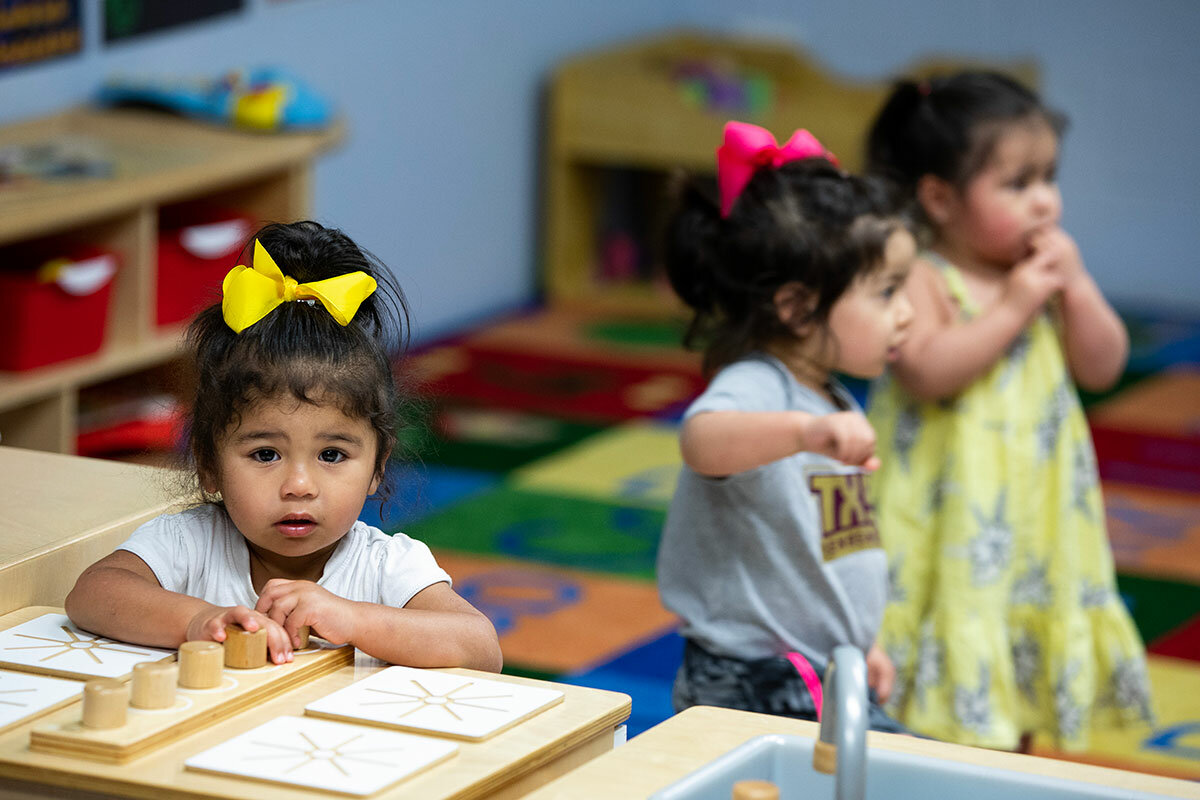
The lockdown work-from-home era may be over. But in many cases, the post-pandemic office is friendlier to mothers than the pre-pandemic version.
Mindy Savides, an 11-year veteran of The Clorox Company, remembers the old days when she left early for child care pickup. “I was the sole person walking out of the office at 4:30, 4:45, and I worked on an open floor plan with a very big team,” says the mother of three. “It did not go unnoticed.”
Now, the office is far more flexible, where teams decide how many days a week people should come into the office. And work hours have become far more flexible so that workers can say they’re dropping off their children at school so they won’t be available for video calls before 9:30 a.m. “This is, like, game changer,” Ms. Savides says. “I can put that [restricted availability] out there without any concern of being that lone sheep.”
Not all employers have been so accommodating. A year ago, Elon Musk brought all Tesla workers back to the office, famously saying anything less than 40 hours a week there was “phoning it in.” He instituted a similarly strict policy when he acquired Twitter later that year. JPMorgan Chase has also instituted a five-day-at-the-office schedule for managing directors, salespeople, and retail branch workers, although CEO Jamie Dimon has acknowledged the disproportionate burden of child care on women. “Modify your company to help women stay home a little,” he said earlier this year.
Financial services companies, such as Goldman Sachs and Citigroup, have been particularly insistent that workers return to the office, as have several tech companies, including Amazon, Apple, IBM, and Meta.
“Someone could always say, ‘Do what you did prior to the pandemic,’” says Joy Chun, a mother of two who works for a financial services company in New Hampshire. “Well, my kids are of an age that they don’t need [a nanny] full time.” And the uncertainty of when her company asks her to come into the office, often on short notice, makes it difficult to plan child care.
Summers are the toughest. “They’re wanting to go to the mall; they’re wanting to get together with their friends,” Ms. Chun says. “When I’m working from home, they can have whoever they want to come over. [But] I don’t feel comfortable when there’s no adult at home for them to do that.
“I would say the stressor is really trying to keep my kids happy, and not just stuck at home by themselves,” she says. “It’s part of the working-mom guilt.”
Some working mothers, like Lixiao Wang, have thrived by going into an office. With remote work, “the boundary is very blurry,” Ms. Wang says. “Your desk is right in your bedroom. When you wake up, you see your work. And then when you go to bed, it’s still there.”
When she works in person, however, there’s more of a sense of “closure” at the end of the day. Ms. Wang, who works in Manhattan for a large bank, says she has certain advantages that make in-person work more feasible. Her 13-year-old son is old enough to maneuver the city on his own. “He takes the bus; it’s very safe.” And she has a short commute.
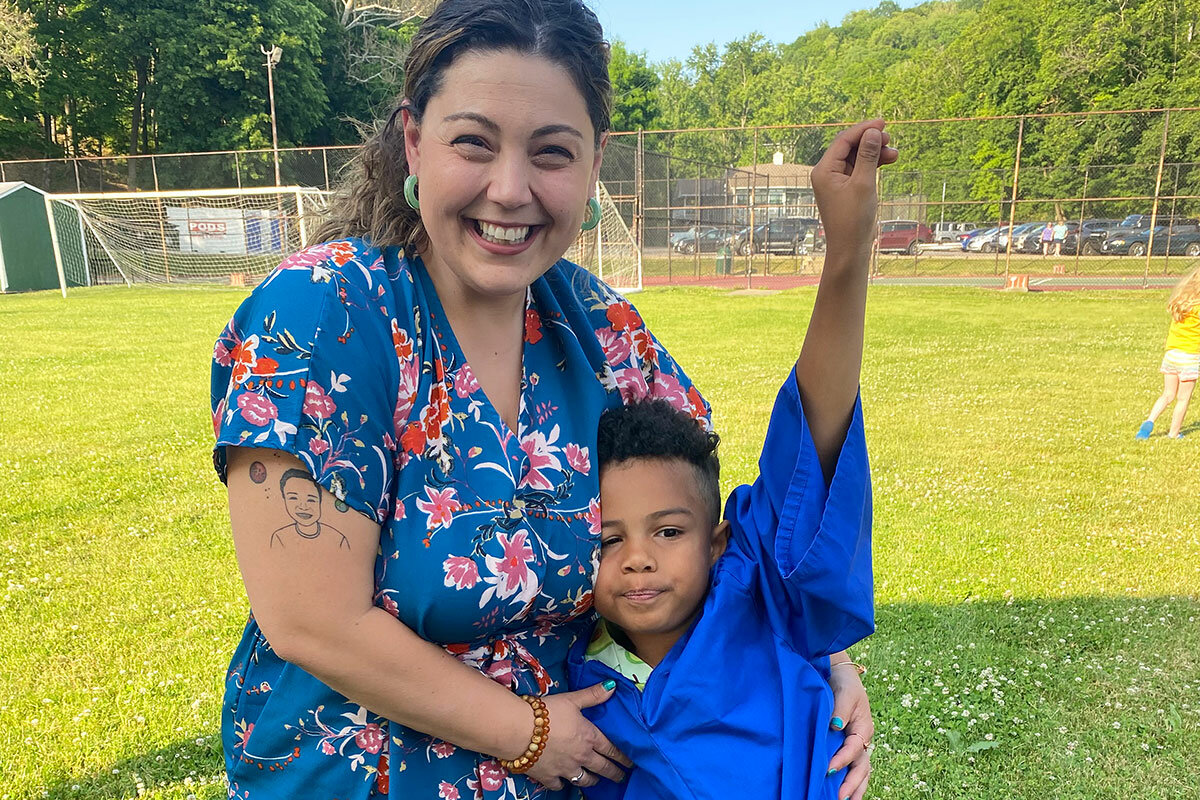
Even some single moms, like Tori Snyder, have been surprised by the upside of going to an office. Long before the pandemic, the Pittsburgh-based single mother had gotten remote work down to a science. She ran her own business and worked as a consultant.
“Part of the reason why I liked being able to work from home was that I could maximize my time. I could do laundry, meal prep, walk the dog, clean. I could do all the things that I needed to do at home so that when my son was home from preschool, I could dedicate that time to just him,” she explained. “My concern was that if I went to a full-time job, I wouldn’t have those hours at home. ... But actually, the very opposite happened.”
After getting an offer from a client in business development, she began working in an office in March, which gave her structure and boundaries. “I think I was just trying to do too much in a day when I worked remotely. And I felt like I was rushing all the time,” she says. The structure has been good for her son, too. “He knows Mommy has an office, that Mommy goes to the city, that Mommy has to do something.”
The advantages she has – her mother helps with child care, and her team at work has been flexible and supportive – aren’t available to all mothers, especially those in lower income brackets.
“In the underserved areas, you have a much higher percentage of single moms,” says Arthur Langer, founder of Workforce Opportunity Services, a nonprofit that recruits, educates, trains, and hires workers from underserved communities. They can’t afford child care, if it’s even available, which means his organization, beyond hiring the mother as a contract worker for a company, sometimes steps in and subsidizes child care. If all works well, the company eventually hires her directly with enough of a pay boost so she can afford child care.
If there’s one commonality these working mothers share, it’s the importance of good and affordable child care. The pandemic – at one point lockdowns closed down about two-thirds of day care centers – has focused a bright light on the need. Red states as well as blue states have begun to enact child care subsidies, and the system has rebounded to pre-pandemic levels, says Anne Hedgepeth, chief of policy and advocacy at Child Care Aware of America, a nonprofit advocacy group that is pushing for federal subsidies for working mothers. The problem is that the system is still up to 3.6 million slots short of the need, she adds.
It’s not clear that enough states or corporations, even those pulling employees back to the office, can fill that gap. “You shouldn’t have to win the boss lottery or the geography lottery in order to have families and businesses thrive,” says Kristin Rowe-Finkbeiner, executive director of MomsRising Together, a group advocating more federal support for child care. She’s optimistic that the growing momentum behind child care support will carry over at the federal level. “It’s no longer a question of if but when we build the care infrastructure we all need.”

Behind the sending of cluster bombs to Ukraine
As the U.S. prepares to share cluster munitions with Ukraine for use against Russian troops, the ethics of a controversial weapon (banned by more than half of nations) have come under scrutiny.

- Quick Read
- Deep Read ( 5 Min. )
Cluster munitions can be seen as an imperfect response in a war currently lacking perfect answers. Ukraine’s slow-moving counteroffensive needed a jolt and ammunition to sustain it. Both needs will be helped by the weapons that President Joe Biden agreed on Friday to send to Ukraine, say military experts.
But the weapons also carry obvious risks. They can be highly dangerous for civilians, and humanitarian groups have already objected to the announcement. Many of the key countries supporting Ukraine – such as the United Kingdom and Germany – are party to the Oslo Convention on Cluster Munitions, a treaty banning their use.
Ultimately, President Biden decided that Ukraine can best determine how to protect its own civilians and that the risk of more unexploded ordnance is outweighed by the risk of not liberating more territory, and civilians, from the Russians. There’s little moral clarity in such an assessment, but that’s often the case in war.
“There isn’t a good answer here,” says a former artillery officer who is now an analyst at the Center for Strategic and International Studies, a Washington think tank. “Either he gives these weapons, with the humanitarian concerns, or he doesn’t, and the Ukrainian offensive is less effective.”
Behind the sending of cluster bombs to Ukraine

President Joe Biden’s decision last Friday to send Ukraine cluster munitions didn’t come easily.
It took 42 U.S. aid packages, a request from Ukraine, another from four leading Republicans in Congress, and a unanimous recommendation from the National Security Council before the president was persuaded.
“It took me a while to be convinced to do it,” President Biden said in an interview with CNN last week. “But the main thing is they either have the weapons to stop the Russians now … or they don’t.”
Cluster munitions can be seen as an imperfect response in a war currently lacking perfect answers. Ukraine’s counteroffensive has wrenched free less than 160 square miles after more than a month of fighting. The slow pace needed a jolt and ammunition to sustain it in the long term, say military experts. Cluster munitions will help with both, they add.
But the weapons also carry obvious risks, including to alliance unity. Many of the key countries supporting Ukraine – such as the United Kingdom and Germany – are party to the Oslo Convention on Cluster Munitions, a treaty banning their use. The controversial weapons can be highly dangerous for civilians, and humanitarian groups have already objected to the announcement.
Ultimately, the choice to send cluster munitions, or cluster bombs, to Ukraine could be seen as a kind of resignation. The president decided that Ukraine can best determine how to protect its own civilians and that the risk of more unexploded ordnance is outweighed by the risk of not liberating more territory, and civilians, from the Russians. There’s little moral clarity in such an assessment, but that’s often the case in war.
“There isn’t a good answer here,” says Mark Cancian, a former artillery officer who is now an analyst at the Center for Strategic and International Studies, a Washington think tank. “Either he gives these weapons, with the humanitarian concerns, or he doesn’t, and the Ukrainian offensive is less effective.”
An ammunition shortage
Speaking from the White House and Pentagon podiums last week, administration officials came prepared with points and counterpoints.
Their arguments fell into four main buckets. The first is that Russia has throughout the war used rocket-fired cluster munitions to attack Ukraine, which is now only using these weapons in self defense. The second is that Kyiv has committed in writing to only use the weapons on its own territory and not to fire them in densely populated or urban areas.
Additionally, they argued that Russia’s cluster munitions have a much higher dud rate – important because shells that don’t explode at first can kill civilians later – than those Ukraine will receive.
The final point may be the clearest. Without these supplies, Ukraine could face an ammunition shortage that would hamstring its counteroffensive. Cluster munitions will help them get through the crunch.
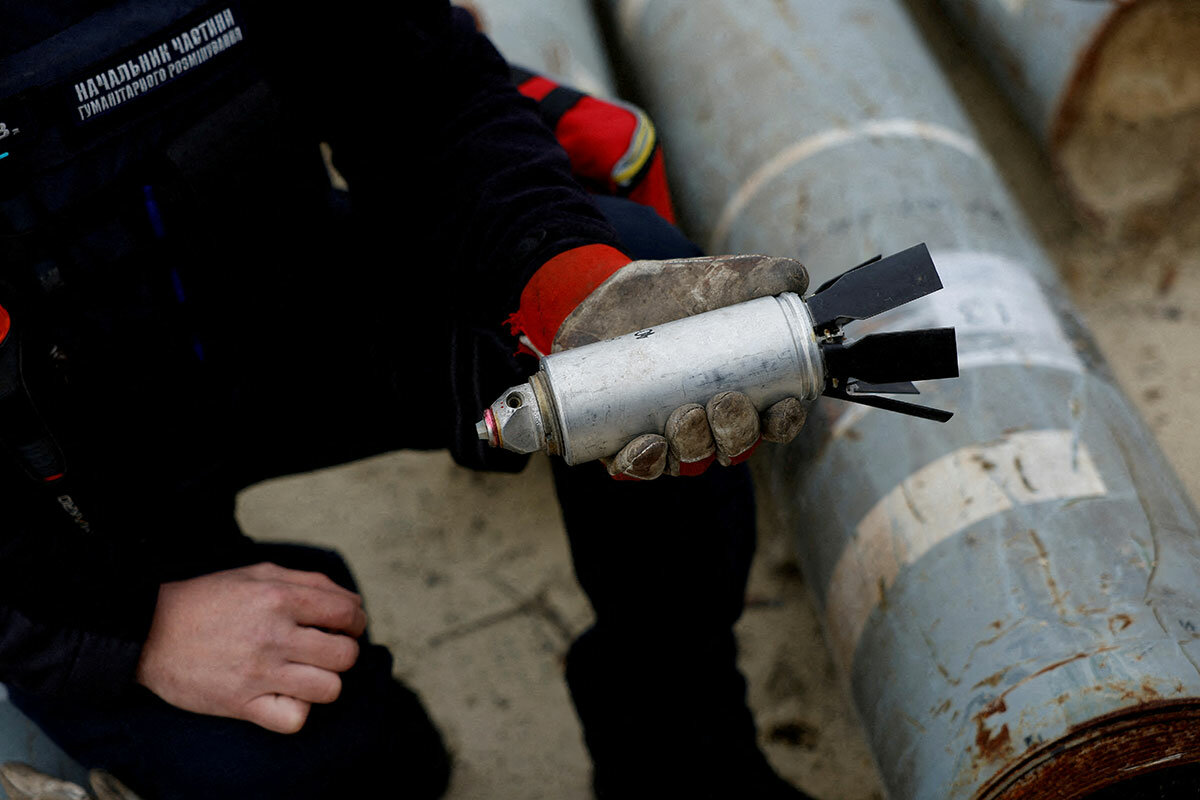
American and European defense industries – unprepared for an arduous war like Ukraine’s – have been ramping up to meet its needs since last February. The United States has already committed 2 million 155 mm shells, in addition to hundreds of thousands from other partners, but it hasn’t been enough.
Cluster munitions include dozens of bomblets inside a larger artillery shell. These kill more adversaries than individual rounds, allowing fewer shells to be fired overall and helping sustain the war effort while America’s industrial base tries to catch up.
Supporters add that these are exactly the kinds of munitions Ukraine needs in the current stage of the war. Russian defensive lines are nearly 20 miles thick in most areas and have multiple layers of minefields, trenches, and antitank structures, let alone Russian forces. These weapons will allow Ukraine to strike a more diffuse target – and with a relatively high degree of accuracy, at least according to Colin Kahl, under secretary of Defense for policy. He said the cluster munitions Ukraine will receive have a dud rate under 2.35%.
“A cluster munition is not a cluster munition,” said Dr. Kahl, speaking from the Pentagon briefing room last Friday. “There are big differences between them.”
Risk to civilians
Dr. Kahl said that 2.35% is based on five Department of Defense studies from 1998 to 2020. But the tests themselves are classified, and there are no plans to make them publicly available.
All of this adds to the skepticism of humanitarian groups, who warn that cluster bombs have already killed and will kill more civilians in this conflict.
A report from Human Rights Watch, released just before the administration’s announcement last week, reported that Ukrainian use of cluster munitions in the siege of Izium last fall resulted in eight civilian deaths and 15 more injuries. The Ukrainian government, which has previously received cluster munitions from Turkey, denied the findings.
Mary Wareham, advocacy director of Human Rights Watch’s arms division, is unconvinced by Dr. Kahl’s claim that not all cluster munitions are the same. “There’s good cluster munitions and there’s bad cluster munitions,” parrots Ms. Wareham. “This is what U.S. officials have tried to argue for years.”
In the past, the dud rate for U.S. cluster munitions has turned out to be higher than projected, causing civilian and soldier harm. During the first Gulf War in 1991, about 10% of all U.S. soldiers killed lost their lives from friendly fire unexploded ordnance.
There are different kinds of munitions testing, with varying levels of accuracy, and tests rarely project actual battlefield numbers. The bomblets inside cluster munitions are meant to explode perpendicular to the target. If weather conditions alter their orientation, or the ground is soft or uneven, the munitions are more likely to end up as duds.
The dud rate of the M42 munition – which is reportedly being sent to Ukraine – has been above 14%. About half of the dud munitions are active, meaning they can explode later. And there’s no way to tell whether a dud is truly a dud or a bomb waiting to go off, complicating the eventual task of clearing minefields.
“Adding [cluster munitions] to that problem makes it more time consuming, makes it more challenging, makes it more dangerous, because you can’t move the submunitions,” says Mark Hiznay, associate director of Human Rights Watch’s arms division. “They all have to be destroyed in place.”
To this, Ukrainians respond that de-mining will already take years, if not decades. The government’s goal right now is to liberate territory. They’ll take everything they can get to accomplish it.
“Our calculus is simple: Having them is less risky than not having these weapons,” says Yuriy Sak, an adviser to Ukraine’s minister of defense.
Some of the worst mass-casualty attacks of the war have been inflicted by Russian cluster bombs. The bombing of a railway station last April in the eastern city of Kramatorsk killed more than 60 and injured more than 150. A mother and daughter lost their legs. The story soon became a symbol of Russia’s indiscriminate attacks on Ukrainian civilians.
Regular Ukrainians are unlikely to be familiar with the technical side of the weapons, says Mr. Sak. But they know cluster munitions.
“If you ask an ordinary Ukrainian in the street what do you think about Ukraine getting cluster munitions I’d probably guess that their answer would be, ‘it’s about [expletive] time,’” he says.

Contrarian or crank? The zeitgeisty campaign of RFK Jr.
The scion of America’s most famous political family has tapped into a surprising well of grassroots support, at a time when distrust and conspiracy theories surround everything from elections to health to the news itself.
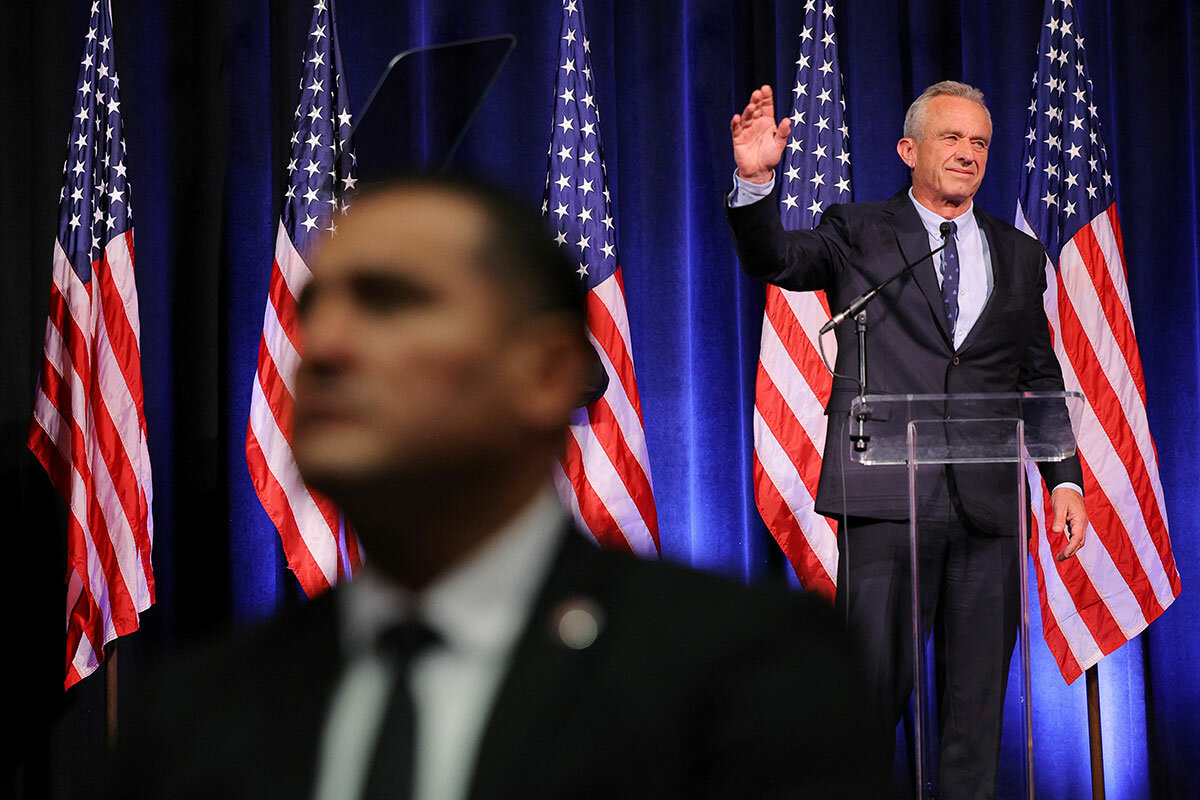
- Quick Read
- Deep Read ( 10 Min. )
When Robert F. Kennedy Jr. announced his candidacy for the Democratic presidential nomination in April, vowing to end the “corrupt merger of state and corporate power,” George Stuscavage was captivated.
A self-described “conservative independent” from North Port, Florida, Mr. Stuscavage voted for Donald Trump in 2016 but grew disenchanted with both political parties. The pandemic, with its mandated lockdowns and public health orders, led him to further question the advice and motives of those in authority.
“We need a lightning rod in the White House who speaks the truth,” he says. Mr. Kennedy “is the person who will change the debate.”
To the surprise of many, several highly rated June polls found Mr. Kennedy with double-digit support among voters. Some of that can likely be attributed to the Kennedy name and Democrats’ lack of enthusiasm for President Joe Biden. But some is coming from voters like Mr. Stuscavage, who feel alienated from America’s two-party system and the institutions that are entwined with it.
While Mr. Kennedy may not pose any real threat to Mr. Biden, the grassroots support fueling his bid offers a window into this polarized, skeptical moment in American politics, when trust is in short supply and the line between “truth” and “misinformation” seems increasingly blurred.
Contrarian or crank? The zeitgeisty campaign of RFK Jr.
Until recently, George Stuscavage didn’t know much about Robert F. Kennedy Jr. He knew Mr. Kennedy was skeptical of vaccines and that a lot of people disagreed with him. But Mr. Stuscavage, a retired bowling center manager from North Port, Florida, didn’t really have strong opinions on vaccines.
Then the pandemic happened, with its mandated lockdowns and public health orders. Mr. Stuscavage found himself increasingly doubting the advice and motives of those in authority, who seemed intent on shutting down any form of dissent.
So when Mr. Kennedy announced his candidacy for the 2024 Democratic presidential nomination in April – vowing to end the “corrupt merger of state and corporate power” that, he said, was threatening to “poison our children and our people with chemicals and pharmaceutical drugs, to strip-mine our assets, to hollow out the middle class and keep us in a constant state of war” – Mr. Stuscavage was captivated. Since then, he estimates he’s spent more than 100 hours listening to Mr. Kennedy’s appearances on various podcasts.
To the surprise of many political strategists and pollsters, Mr. Stuscavage is far from alone. In a number of highly rated June polls, Mr. Kennedy was found to have double-digit support among voters, with, in some cases, close to 1 in 5 Democratic voters favoring him over incumbent President Joe Biden.
Some of that can be attributed to his name. When asked by the Monitor what they like about the longtime environmental lawyer and vaccine skeptic, several supporters cite their appreciation for former President John F. Kennedy (Mr. Kennedy’s uncle), or former attorney general and presidential candidate Robert F. Kennedy (Mr. Kennedy’s father), or just the Kennedy family in general. Democrats’ lack of enthusiasm for President Biden – national polls suggest fewer than 40% want Mr. Biden to be their nominee in 2024 – is likely also boosting Mr. Kennedy’s candidacy.
But another undeniable thread of support is coming from liberal and conservative voters alike who have become alienated from America’s two-party system and the public and private institutions that are entwined with it. Just as former President Donald Trump staged a hostile takeover of the GOP in 2016 by tapping into voters’ political and economic frustrations, Mr. Kennedy’s candidacy seems emblematic of a post-Jan. 6, post-pandemic nation, where distrust and conspiracy theories surround everything from elections to public health to the news itself.
To be sure, it’s unlikely Mr. Kennedy will pose any real threat to Mr. Biden’s path to the nomination. The Biden campaign has ignored his candidacy so far, while other Democratic Party operatives openly dismiss him as a crank.
“Joe Biden is going to be in a solid position next November because of the extremism we have seen from folks like RFK and across the Republican Party,” says strategist Andrew Feldman. “We pride ourselves on being a big tent. But what RFK Jr. has been pushing has no place in our party.”
Still, less-well-known candidates than Mr. Kennedy have managed to play spoiler in past elections. He has ties to prominent figures from the tech and finance industries, who’ve held fundraisers for him and spoken approvingly about his candidacy, as well as to Hollywood through his third wife, actress Cheryl Hines.
And even if Mr. Kennedy’s current poll numbers represent the high-water mark for his campaign, the grassroots support fueling his bid offers a telling window into this polarized, skeptical moment in American politics – when many voters don’t feel at home in either political party, and the line between “truth” and “misinformation” seems increasingly blurred.
“He talks rationally, reasonably, and he doesn’t dismiss anyone’s opinion,” says Mr. Stuscavage. “So much of what we hear on TV is proven wrong. The way they ridiculed anyone who believed the [COVID-19] lab leak – and now it looks like it’s true. All this stuff is enraging to me.”
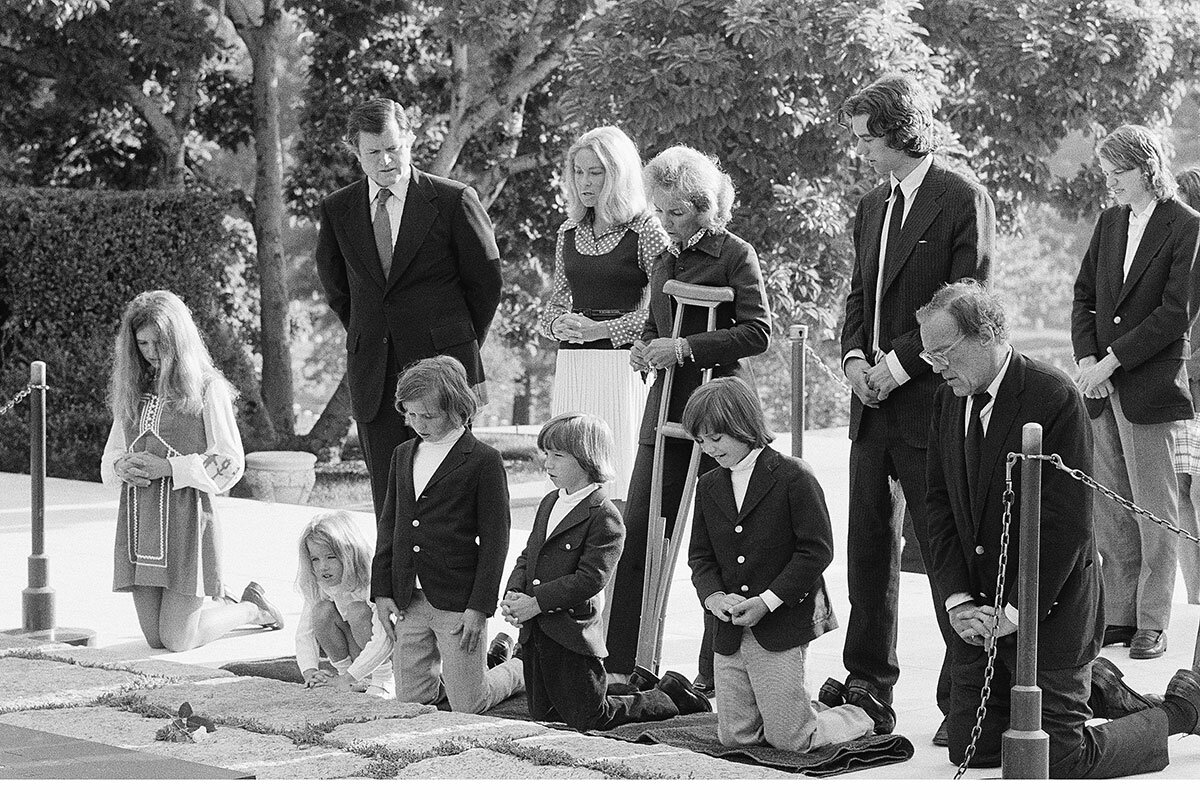
A life in the public eye
On paper, Mr. Kennedy certainly has the pedigree to be a contender in a Democratic primary. A scion of America’s most famous political family, he was a young boy when his uncle John F. Kennedy was elected president. He was a teenager when his father announced his own presidential campaign, before he too, like his brother, was assassinated. Mr. Kennedy, who struggled with drug addiction as a young man, attended Harvard University and the University of Virginia School of Law before becoming a prominent environmental lawyer known for holding powerful, polluting corporations to account. He was a leader in cleaning up New York’s Hudson River and founded the Waterkeeper Alliance, one of the largest water protection groups in the world.
Then, in the early 2000s, as Mr. Kennedy was speaking out about the dangers of mercury in fish, his interests expanded.
“These women start showing up at every lecture that I give,” Mr. Kennedy recounted to podcast host Joe Rogan in a recent interview. The mothers of “intellectually disabled children” would arrive early and sit in the front row and ask to speak with Mr. Kennedy after his lecture. They told him that they believed their children were injured by mercury in vaccines. “They would say to me in a respectful but vaguely scolding way, ‘If you are really interested in mercury contamination, exposure to children, you need to look at the vaccines.’”
As Mr. Kennedy tells it, his years of work for environmental causes had predisposed him to trust sources in the field over scientists. Fishers, he says, often know about water problems before government officials. He started reading studies on mercury in vaccines and soon became consumed. In 2005 he wrote an infamous article for Salon arguing that vaccines cause autism – an article that was subject to multiple corrections and eventually taken down from the site. Undaunted by the criticism, Mr. Kennedy went on to found the Children’s Health Defense, a nonprofit dedicated to the vaccine issue, and to publish books on the subject. Numerous scientific studies have not found any link between autism and vaccines.
Over the past two decades, Mr. Kennedy has prominently voiced other debunked or unsubstantiated claims, including that the CIA was involved in the assassinations of his uncle and father, and that Democrat John Kerry actually won the 2004 election against former President George W. Bush. He has posited that Wi-Fi harms the brain, that a harmful chemical in the water supply is causing gender dysphoria, and that the rise in mass shootings is linked to antidepressants.
But it’s the vaccine issue that seems to have drawn in many of his supporters. When the COVID-19 pandemic upended American life in early 2020, and getting back to normal was in many places predicated upon a brand-new vaccine that had been developed in record time, anti-vaccine sentiment suddenly became a much louder voice in the public square.
“Vaccines have been one of the most important medical advancements in human history – saved countless lives,” said Mr. Rogan, who has been criticized for recommending discredited COVID-19 remedies to his millions of followers, when speaking with Mr. Kennedy on an episode that aired last month. “And I thought very strongly that they were important. ... Then the pandemic happens.”
Mr. Kennedy, who says he is not opposed to vaccines but is concerned with vaccine safety, was poised to pick up the charge. In 2021, he published his book “The Real Anthony Fauci: Bill Gates, Big Pharma, and the Global War on Democracy and Public Health,” which sold over 1 million copies and brought a new round of notoriety, setting the stage for his presidential run.
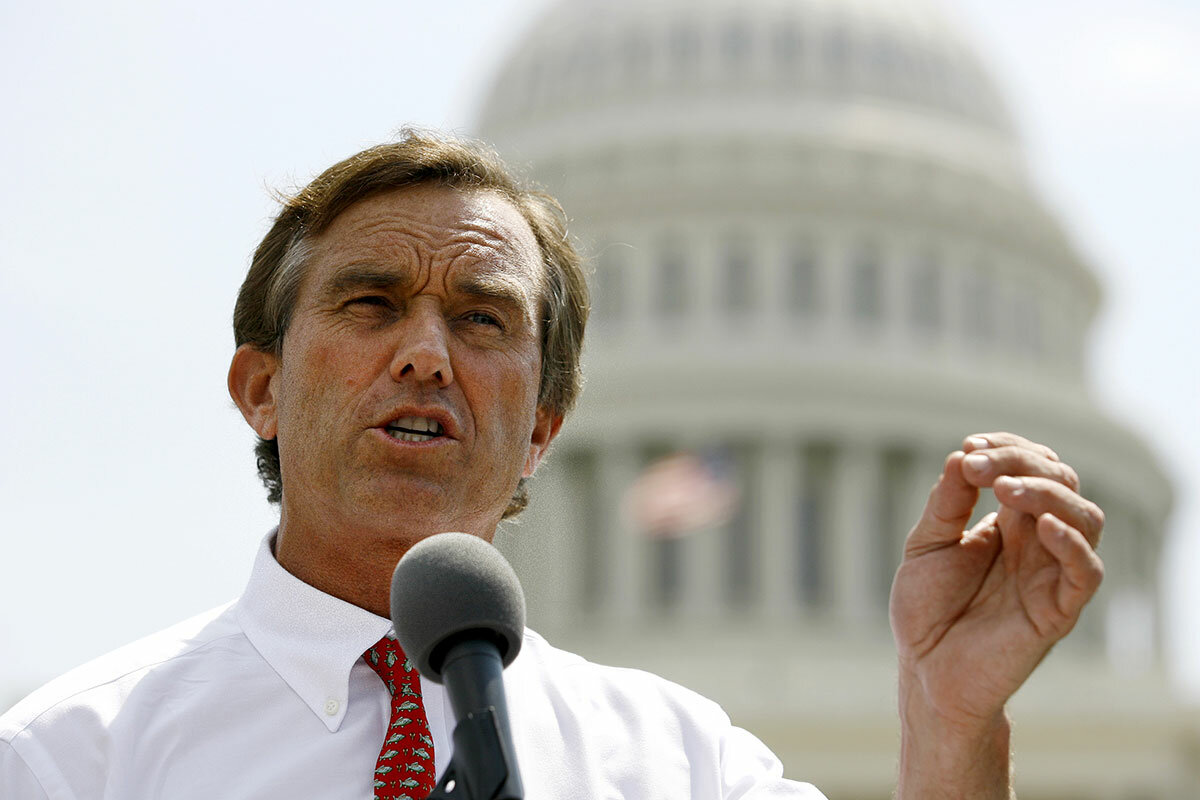
The podcast circuit
That Mr. Kennedy’s book on Dr. Fauci was harshly criticized and even removed by some sellers only further endeared him to supporters. To many, the attacks on Mr. Kennedy were symbolic of America’s diminishing protections around free speech, as mainstream news outlets and social media companies suppressed “anti-vax” voices for posing a danger to public health. Instagram banned Mr. Kennedy’s account two years ago for “repeatedly sharing debunked claims about the coronavirus or vaccines,” before reinstating it last month due to his presidential campaign.
Just as Mr. Kennedy’s support reflects a growing distrust of institutions and expertise, his approach to campaigning speaks to 2023’s fractured media landscape. He has appeared primarily on podcasts, speaking for hours at a time with popular hosts who are critical of traditional media like Mr. Rogan, Bill Maher, Bari Weiss, and Russell Brand.
“I do have a chance with podcasts, because I’m able to outrun the censorship juggernaut,” Mr. Kennedy recently told The New Yorker.
Rather than reducing his visibility, this strategy appears to be paying dividends at a time when network news is “significantly reduced in power,” says Matt Sienkiewicz, chair of the communications department at Boston College and author of a book on right-wing comedy and podcasters like Mr. Rogan. Mr. Kennedy’s momentum should be seen as “largely a media story,” he says.
“It’s unprecedented to have such a national reach with such unbounded time frames,” says Mr. Sienkiewicz. “The idea of getting 90 or 120 minutes with a national audience like Rogan has – that’s completely new, and well suited for a candidacy like this. Without these opportunities, it would be hard to see him where he is now.”
Not all presidential candidates want to participate in such long, wide-ranging conversations, for fear of saying something that could be used against them later. “[South Carolina Sen.] Tim Scott isn’t going to want to talk to Joe Rogan for 190 minutes,” adds Mr. Sienkiewicz.
In that sense, Mr. Kennedy may have more in common with Mr. Trump than with Mr. Biden. Indeed, Mr. Trump has spoken favorably of Mr. Kennedy, and Trump ally Roger Stone recently tweeted out a mock “Trump-Kennedy 2024” campaign sign.
Like Mr. Trump, Mr. Kennedy “is not taken seriously, doesn’t have a lot of experience in politics, considers himself an outsider, and says things other candidates aren’t saying,” says Adam Enders, an expert on conspiracy theories at the University of Louisville in Kentucky. Most notably, both men blend “populist tendencies and an anti-elite flair” with just enough party-line policies to pacify some of the same elites they promise to fight, he says.
Ideologically, Mr. Kennedy is hard to pin down. He supports abortion rights and affirmative action but opposes gender-transition treatments for minors. He is skeptical of gun control measures, has been critical of U.S. involvement in the war in Ukraine, and says he would impose higher taxes on wealthy Americans. He hired former Ohio Rep. Dennis Kucinich – one of Congress’ most liberal members – as his campaign manager but speaks highly of former Fox News host Tucker Carlson, who has lavished praise on him in return.
The Kennedy campaign did not respond to requests for comment.
Fans on the left and right
Scroll through some of the Kennedy for President Facebook groups, and it’s clear that his outsider persona is a big source of his appeal. In these forums, Republicans and Democrats alike vent their frustrations with the two parties and their likely presidential nominees. Many see Mr. Kennedy as a fresher option, despite the fact that he’s only eight years younger than Mr. Trump and 11 years younger than Mr. Biden. Women re-post and “like” recent videos of Mr. Kennedy bench-pressing and doing pushups, shirtless.
“It’s time for the next generation to step up,” says Ray Tetro, a retiree from New Jersey who voted for Hillary Rodham Clinton in 2016 and Mr. Biden in 2020, and now supports Mr. Kennedy for 2024. “I think he represents the values of a younger generation.”
Many Kennedy supporters also say America needs a different kind of leader to “unite” the country.
“Biden said on the stump, ‘I am going to bring this country together,’ but he didn’t even make it to the Oval Office before that went down the drain,” says Vicki Little, who retired from local newspaper delivery in upstate New York. After voting for Mr. Trump twice, she already has the paperwork to change her party registration from Republican to Democrat so she can vote in her state’s primary for Mr. Kennedy.
Ms. Little especially likes the fact that she, a former Trump supporter, can have good conversations about Mr. Kennedy with her daughter, a Bernie Sanders supporter.
The “horseshoe theory” in political science posits that voters on the far right and far left can be closer together ideologically than either are with moderate voters, and some see Mr. Kennedy’s candidacy as evidence of this. Others see his mashup of support as more a sign that tribal identification isn’t really about a set of deeply held beliefs. “People can be polarized about certain things, and they can be polarized in this squishy, identity-based way,” as the University of Louisville’s Mr. Enders puts it.
Mr. Stuscavage considers himself a “conservative independent” and has always voted for Republicans. He’s even volunteered for the campaigns of conservatives like former Texas Rep. Ron Paul and the late Arizona Sen. John McCain. He voted for Mr. Trump in 2016 but soon grew disenchanted with him, changing his party registration from Republican to nonpartisan and sitting out the 2020 election. Next year, when he plans to vote for Mr. Kennedy, will be the first time he has ever voted for a Democrat.
“We have been deceived for so long, and by both parties,” says Mr. Stuscavage. “[Mr. Kennedy] is the person needed to change the debate. We need a lightning rod in the White House who speaks the truth.”

How a new museum reclaims history from horror
How do you turn a site of horror into one of healing? The question of how to honor those whose lives were stolen informs every detail at the new International African American Museum in Charleston, South Carolina.
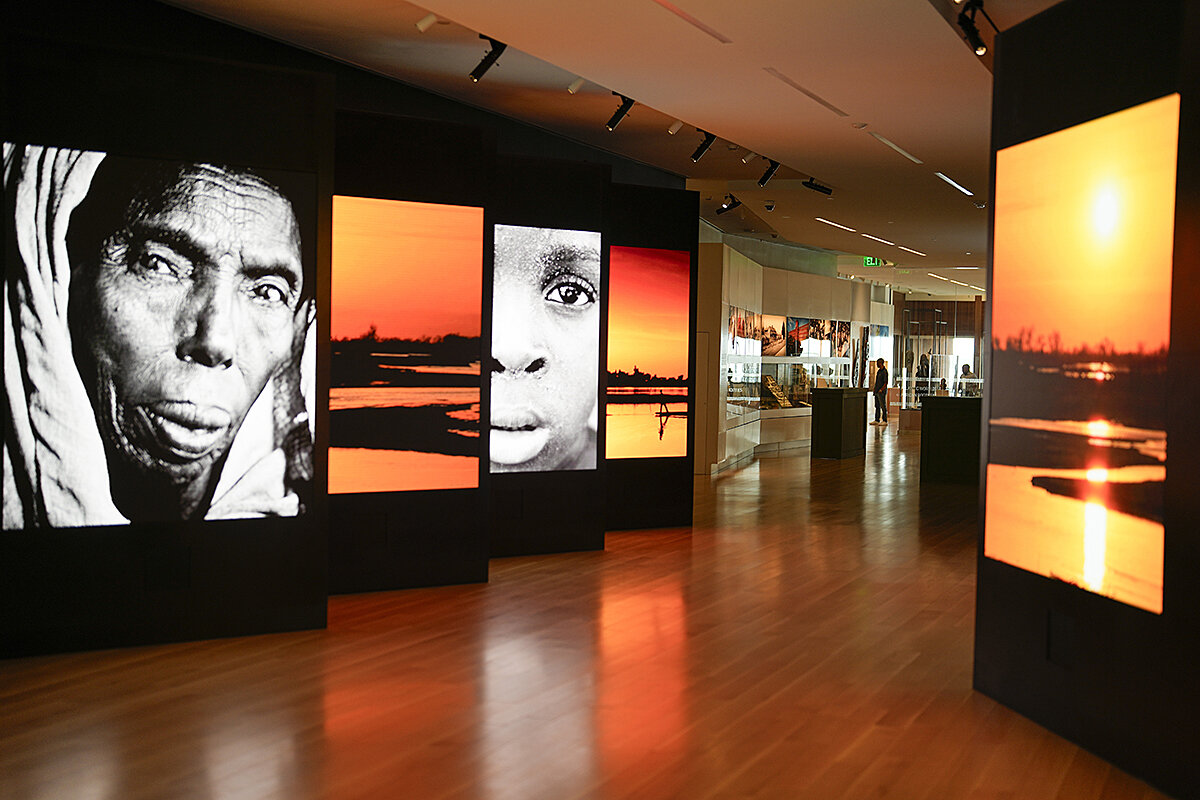
- Quick Read
- Deep Read ( 7 Min. )
How does ground zero become hallowed ground?
The new International African American Museum (IAAM) in Charleston, South Carolina, is an exercise – rather, an exultation – in the importance of such work.
As the museum’s director of education and engagement for faith-based communities, the Rev. DeMett Jenkins identifies the importance of spiritual healing and community in the museum’s development.
“That’s why the building is lifted 13 feet up, because we didn’t want ... to just plant a building on this ground,” Reverend Jenkins says. “Why? When the souls of our ancestors stepped on it? We want to make sure that we put our feet within their feet and that we live out the prayers that they have been praying for.”
Second in size to only the National Museum of African American History and Culture in Washington, D.C., the museum is carefully curated – a meticulous labor of love.
At the end of the American Journeys timeline, there is a fluorescent sign for the IAAM, with the first A faded out. “I AM,” the light reads, and letters on the floor spell out “STILL HERE.”
Leslie Abraham stands a few feet away, overcome with emotion.
“I haven’t made it 20 feet in ... and I had to stop and just take a moment,” Ms. Abraham says. “We are forgiving people, after all that has been done to us and has been taken from us. But God. We thrive.”
How a new museum reclaims history from horror
How does ground zero become hallowed ground?
The new International African American Museum (IAAM) in Charleston, South Carolina, is an exercise – rather, an exultation – in the importance of such work.
As the museum’s director of education and engagement for faith-based communities, the Rev. DeMett Jenkins identifies the importance of spiritual healing and community networking in the museum’s development. As a proud “Gullah Geechee girl” and the granddaughter of Esau and Janie Jenkins, local trailblazers in health care and transportation, she appreciates the social justice component of this “sacred space.”
“That’s why the building is lifted 13 feet up, because we didn’t want – the architects didn’t want – to just plant a building on this ground,” Reverend Jenkins says. “Why? When the souls of our ancestors stepped on it? We want to make sure that we put our feet within their feet and that we live out the prayers that they have been praying for.”
It is perhaps fitting, then, that a worship service kicked things off for the museum at the iconic Morris Brown African Methodist Episcopal (AME) Church in Charleston on June 22. Brown was one of the founders of the AME Church and founded the former Hampstead Church, now known as Emanuel AME Church. “Mother Emanuel” has been the target of multiple racist attacks since its founding, including in 2015, when a white teenager opened fire and murdered nine Black people at prayer.
Ms. Jenkins called the service a “celebration of liberation,” and spoke about making history a priority in faith communities.

“Besides school and home, we spend most of our time in somebody’s house of worship,” she explains, sitting in an office adjacent to the museum’s Center for Family History. “And so we have the responsibility of teaching and educating and informing just as much as any mother or father in their home. And so this ground is sacred.”
I attended the museum on the last day of June, a few days after its grand opening on June 27. The museum was carefully curated – a meticulous labor of love. Exhibits focused on “local, state, national and international” components of Black history and chronicled a history from 300 B.C. to the present day.
Second in size to only the National Museum of African American History and Culture in Washington, D.C., the International African American Museum is home to 12 permanent exhibitions, including nine galleries and a special exhibitions gallery, which will rotate two to three exhibits annually. Through Aug. 6, one of those displays, “Men of Change: Power. Triumph. Truth.” will highlight the various contributions of Black activists and entertainers from James Baldwin to Kendrick Lamar.
Honoring History on the Carolina Coast
A new museum went up this summer in Charleston, South Carolina, at the site of Gadsden’s Wharf. From this spot, through which thousands of enslaved people were forced, writer Ken Makin reported a story of progress toward reclamation – and of hard work left to be done. He spoke with host Clay Collins about the transformation of this harrowing place, and about how it left room to celebrate a culture’s will to thrive.
“They say it took almost 20 years to get here,” says museumgoer Ray Alls. “I can see that when you look at the attention to detail. It’s beautiful – long overdue.”
That detail begins on the exterior, where the museum rests at Gadsden’s Wharf. The beauty of the harbor belies the horrors of the country’s history of chattel slavery. The wharf was the first destination in North America for an estimated 100,000 people who were forced into slavery.
“People kind of know that Charleston was a port [for enslaved peoples from Africa], but didn’t really know where and how many. Based on what stats you read, sometimes you’ll see 40% and sometimes you’ll see 48% ... of our African ancestors came right through Charleston,” Ms. Jenkins says. “I always challenge myself when I hear myself say ‘came here,’ I correct myself and say they were ‘forced here.’”
Consider a duo of life-size portraits that rest in close proximity in the American Journeys exhibit, similar in depiction but with a gripping and profound difference.
They tell the story of Frazier Baker, a Black teacher who was appointed postmaster in Lake City, South Carolina, in 1897. He was an appointee of President William McKinley, who sought to promote Black Republicans in the aftermath of his inauguration.
Baker quickly became the target of white angst, and then, white violence. On the morning of Feb. 22, 1898, a mob raided and fired upon Baker’s home – also the town post office. Baker was lynched, and his infant daughter, Julia, was shot and killed. A picture of Baker’s wife, Lavinia, and their five surviving children is on display at the museum.
The picture that accompanies it captures the essence of what the new museum represents. Designed by artist Stan Squirewell, originally from Washington, D.C., it is a re-imagination of the former familial photo that includes Baker and his infant daughter, united with the people who loved them.

The exhibit that recognized Frazier Baker reminds me of my dad, who worked for a time as postmaster during his nearly 40-year career with the U.S. Postal Service. Baker’s story unnerved multiple onlookers, who wept when they saw the reimagined photo of the Baker family.
The museum doesn’t limit itself to a timeline of the nightmare of slavery to the present. Its look back at African roots and African routes dates back to the B.C. era, and its timeline of North American history goes back to the 1400s. The museum’s Center for Family History, which focuses on genealogy, is an example of just how far Black folks have come by faith, explains Ms. Jenkins.
“They’re collecting funeral programs, obituaries, family Bibles with people who already have their names and dates written in them,” she says. “Since we have begun working here, we have already encountered people who have their family Bibles from the 1800s.
“We want to make sure they preserve that Bible well and that they continue to keep that legacy within their family … so that they know their history,” she adds.
Other museumgoers express joy and near speechlessness over the annals of information presented in various ways, from artifacts to short films to video presentations. The more than two acres of land where the wharf stood is now a memorial garden, and black granite walls rise from the site of a former warehouse where Africans were forced to crowd inside before being taken to the market to be sold.
“Breathtaking,” declares Brenda Wrighton. “It’s a lot to take in. I don’t think this can be done in one day.”
“My thoughts are endless – no words,” says Jessie Walker. “Our history being brought to fruition like this – it’s just awesome. This is a way we can teach our children history.”
At the end of the American Journeys timeline, there is a fluorescent sign for the IAAM, with the first A faded out slightly. “I AM,” the light reads, and the subsequent letters on the floor spell out “STILL HERE.”
Leslie Abraham stands a few feet from that sign, emotional over the resilience of “our people.”
“I haven’t made it 20 feet in [to the exhibit], and I had to stop and just take a moment,” Ms. Abraham says. “Our rich history – what we’ve contributed to this nation.
“We are forgiving people, after all that has been done to us and has been taken from us,” she adds. “But God. We thrive.”
Editor's note: This story has been updated to clarify that the first timeline reference referred to the nightmare of slavery.
Other headline stories we’re watching
(Get live updates throughout the day.)The Monitor's View
An American nod to European privacy
- Quick Read
- Deep Read ( 2 Min. )
-
By the Monitor's Editorial Board
Each year, Europe and the United States conduct business worth $7.1 trillion across the Atlantic, much of it in digital information. But that bounty has always come with a risk to the privacy of consumers – something that has eluded the two sides for decades. They may now have a solution. Yesterday they completed a deal that means tech giants like Meta and Google can continue to store the private data of European consumers on computer servers in the U.S. For that to be possible, the agreement had to overcome legal and cultural differences about a cornerstone of democracy: trust.
“I have worked tirelessly with my US counterparts to ... ensure that technological advances do not come at the cost of Europeans’ trust,” said Didier Reynders, the European Union’s commissioner for justice. “But as close like-minded-partners, the EU and the US could find solutions, based on their shared values, that are both lawful and workable in their respective systems.”
The new framework is likely to face legal challenges from the same advocacy groups that successfully challenged previous iterations. But its immediate impact, beyond lifting economic uncertainty, is to affirm the value of individual agency and identity in the control of personal data.
An American nod to European privacy
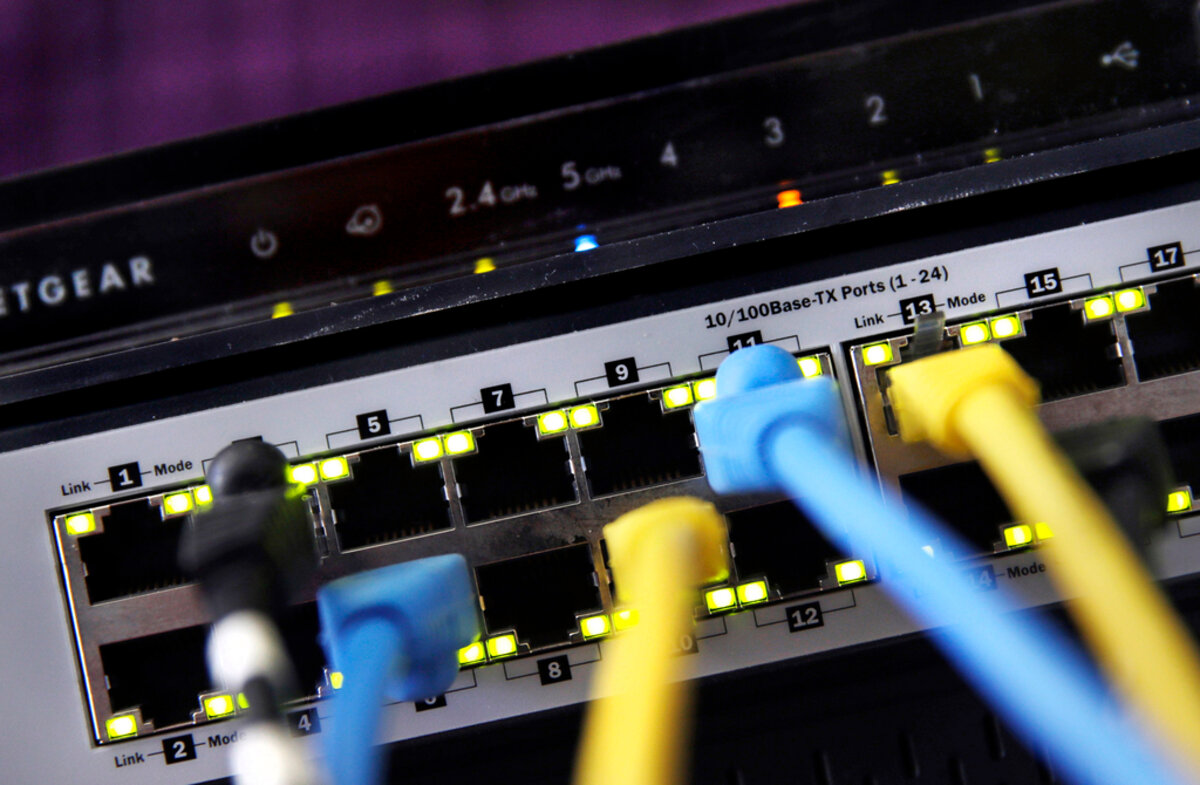
Each year, Europe and the United States conduct business worth $7.1 trillion across the Atlantic, much of it in digital information. But that bounty has always come with a risk to the privacy of consumers – something that has eluded the two sides for decades. They may now have a solution. Yesterday they completed a deal that means tech giants like Meta and Google can continue to store the private data of European consumers on computer servers in the U.S. For that to be possible, the agreement had to overcome legal and cultural differences about a cornerstone of democracy: trust.
“I have worked tirelessly with my US counterparts to ... ensure that technological advances do not come at the cost of Europeans’ trust,” said Didier Reynders, the European Union’s commissioner for justice. “But as close like-minded-partners, the EU and the US could find solutions, based on their shared values, that are both lawful and workable in their respective systems.”
The agreement, known as the EU-U.S. Data Privacy Framework, grows out of two previous agreements that were overturned by Europe’s highest court. In 2015, for example, the court overturned a so-called safe harbor agreement because it failed to protect the online information of European consumers from U.S. government access.
The new deal incorporates provisions from an executive order President Joe Biden issued last fall that gives individual European citizens a right to initiate an official inquiry if they suspect their data has been improperly collected by U.S. intelligence agencies. It also sets up an independent review board to hear such appeals.
In Europe, privacy is “an absolute fundamental right” enumerated under law. In the U.S., the right to privacy has been established differently – by regulations, executive orders, and court decisions. That status makes Americans as nervous as it does Europeans. A poll conducted by the International Association of Privacy Professionals last year, for example, found that 56% of Americans across the political spectrum support legislation establishing privacy as a federal right – including a proposal to prevent social media companies from using personal data without consumers’ permission.
Privacy, says Neil Richards, a law professor at Washington University in St. Louis and author of the 2021 book “Why Privacy Matters,” is an anchor for values that move societies beyond fear and uncertainty. “Privacy matters because it lets us authentically develop our identities as humans, it safeguards our political freedom and autonomy as citizens, and it lets us participate in and trust the digital economy as consumers,” he said last year in a interview in The Markup, a news website devoted to technology.
Although the new framework includes an annual review mechanism to evaluate whether it is properly balancing and safeguarding the privacy concerns of individual Europeans, it is likely also to face legal challenges from the same advocacy groups that successfully challenged previous iterations. Its immediate impact, beyond lifting economic uncertainty, is to affirm the value of individual agency and identity in the control of personal data.

A Christian Science Perspective
Each weekday, the Monitor includes one clearly labeled religious article offering spiritual insight on contemporary issues, including the news. The publication – in its various forms – is produced for anyone who cares about the progress of the human endeavor around the world and seeks news reported with compassion, intelligence, and an essentially constructive lens. For many, that caring has religious roots. For many, it does not. The Monitor has always embraced both audiences. The Monitor is owned by a church – The First Church of Christ, Scientist, in Boston – whose founder was concerned with both the state of the world and the quality of available news.
Overcoming depression with God’s love
- Quick Read
- Read or Listen ( 3 Min. )
-
By Diahana Barnes
We can rise into a more permanent joy through learning of our unity with divine Love.
Overcoming depression with God’s love
There was a time in my life when I experienced a deep depression. There were days when I didn’t want to get out of bed and completely lacked motivation. It was a dark sadness that seemed to be sucking me under. I was not my usual self.
Desperate to feel happy again, I decided to turn to God for help through prayer. Using a foundational truth of Christian Science – that all is created and governed by the divine source, God, Love – I began to pray deeply. With support from teachings in the Bible and its companion textbook called “Science and Health with Key to the Scriptures” by Mary Baker Eddy, I started to deepen my spiritual understanding of God and my unique relationship to our source.
What I was learning included the fact that God is all good and only good. And we, as God’s likeness, are entirely spiritual and also only good. The book of Genesis states, “God saw every thing that he had made, and, behold, it was very good” (1:31). And Science and Health says, “God is Love” (p. 2), echoing the first Epistle of John.
Thinking about all these ideas, I replaced any depressed thoughts with “God is Love.” I thought about what that meant for me, reasoning that since God is Love and created all things, then that creation is good and includes me. If I am one with my spiritual source, how would it be even slightly possible to experience anything unlike Love? Could the source of all goodness also create a feeling of sadness?
I knew the answer was no. Divine Love couldn’t create sadness or depression. And that meant it wasn’t possible for me to be bogged down with depressed thoughts. So I could find the freedom that was always truly mine by focusing on spiritual thoughts and qualities – those that come from God and are harmonious, loving, kind, gentle, and caring.
Depressed feelings are like sludge or mud that tries to pull us down, preventing us from seeing and experiencing the love of God. But the love of God is amazing, all-powerful. We can wash away the mud of depression and negative self-talk, which are false in the light of divine Love, by prayerfully deepening our understanding of the love of God. “Humble yourselves, therefore, under God’s mighty hand, that he may lift you up in due time. Cast all your anxiety on him because he cares for you” (I Peter 5:6, 7, New International Version).
As I continued to pray with these ideas, my thinking became more spiritualized. Thoughts of depression and sadness were increasingly replaced by spiritual thoughts of love, goodness, and joy, and I felt more and more like myself until the sadness was completely gone. The depression has never returned.
We are created, expressed, and composed solely from Love, which means we are now and forever living in harmony. By understanding God’s love for us, we can find peace and joy, even in the midst of our struggles. And, if we’re feeling depressed, we can overcome this and experience more fully our inherent happiness.

Viewfinder
‘The Greatest Outdoor Show on Earth’

A look ahead
We’re so glad you joined us today. Tomorrow, correspondent Carlos Mureithi looks at how content moderators for tech giants in Africa – often tasked with observing the worst corners of the internet – are speaking up for their right to a healthy work environment.
On a housekeeping matter, some of you might have noticed that the Daily came about an hour later than normal yesterday. Breaking news on our lead story about NATO and Turkey meant we had a “stop the presses” moment and had to delay publication to make important edits. Thanks for your patience.


